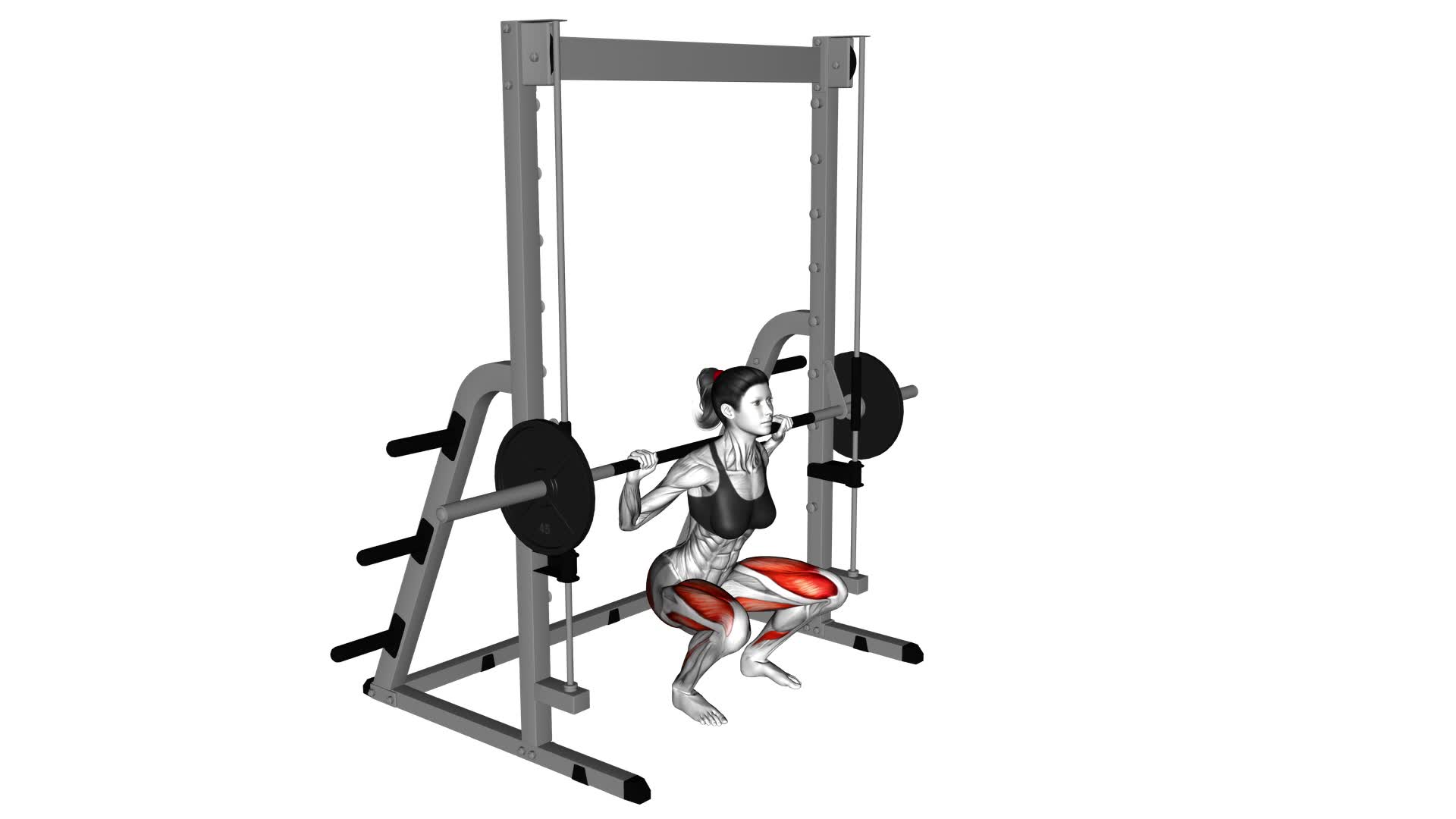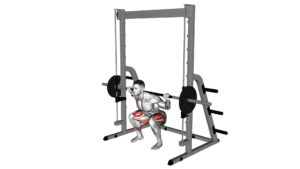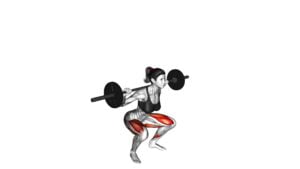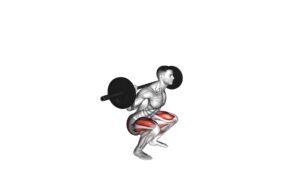Smith Low Bar Squat (female) – Video Exercise Guide & Tips

Looking to improve your lower body strength and build muscle? The Smith Low Bar Squat is the perfect exercise for you!
Watch This Exercise Video
In this video exercise guide, we'll walk you through the proper setup, technique, and common mistakes to avoid.
With our tips and tricks, you'll be able to increase the intensity and progress in weight safely and effectively.
Get ready to see amazing results with the Smith Low Bar Squat!
Key Takeaways
- The Smith Low Bar Squat targets multiple muscle groups simultaneously, including the glutes, hamstrings, and lower back.
- Proper set-up and equipment, such as correct bar placement and safety catches on the Smith machine, are essential for performing the exercise safely and effectively.
- Safety equipment, such as a weightlifting belt, weightlifting shoes, and knee sleeves or wraps, should be prioritized for a safe workout.
- It is important to maintain proper form, avoid common mistakes, and gradually increase weight over time to maximize results and prevent injuries.
Benefits of the Smith Low Bar Squat
You should regularly incorporate the Smith Low Bar Squat into your workout routine for maximum benefits. This exercise offers numerous advantages for your overall strength and muscle development. One of the key benefits of the Smith Low Bar Squat is its ability to target multiple muscle groups simultaneously. By placing the barbell lower on your back, you engage your glutes, hamstrings, and lower back to a greater extent compared to other squat variations. This not only helps to build strength and size in these areas but also improves your overall lower body stability and balance.
Another benefit of the Smith Low Bar Squat is its versatility and adaptability to different fitness levels. Whether you're a beginner or an experienced lifter, you can modify the technique to suit your needs. For beginners, using lighter weights and focusing on proper form is crucial to prevent injury and build a strong foundation. As you progress, you can gradually increase the weight and intensity to continue challenging your muscles and achieving new levels of strength.
Proper Set-Up and Equipment for the Exercise
To properly set up for the Smith Low Bar Squat, it's important to ensure correct bar placement on your back. The bar should rest on your upper traps, just below the base of your neck.
Additionally, essential equipment for safety includes a squat rack or Smith machine, a barbell, and weight plates.
Correct Bar Placement
For proper set-up and equipment for the Smith Low Bar Squat (female), it's essential to ensure correct bar placement. The bar should be positioned lower on your back compared to the high bar squat. This lower bar position allows for greater muscle activation in the posterior chain, including the glutes, hamstrings, and lower back.
To achieve the correct bar placement, step under the bar and position it on your trapezius muscles, just below the acromion process. Make sure the bar is centered and rests comfortably on your back.
Additionally, ensure that the bar is securely locked into the Smith machine and that the safety catches are properly adjusted to prevent any accidents during the exercise.
Essential Equipment for Safety
What equipment is necessary to ensure safety and proper set-up for the Smith Low Bar Squat (female)?
Safety equipment is crucial when performing the Smith Low Bar Squat to prevent injuries and ensure a proper set-up. The first essential piece of equipment is a weightlifting belt, which provides support to the lower back and helps maintain proper form.
Additionally, using a pair of weightlifting shoes with a flat and stable sole can improve stability and prevent injuries. Knee sleeves or wraps are also recommended to provide support and compression to the knee joints.
Lastly, using a Smith machine with safety catches is essential for injury prevention. These catches can be adjusted to the appropriate height to catch the barbell in case of failure or loss of balance.
Prioritizing safety equipment is vital to ensure a safe and effective Smith Low Bar Squat workout.
Step-by-Step Guide for Performing the Smith Low Bar Squat
Start by positioning yourself under the Smith machine barbell. This step-by-step guide will help you perform the Smith Low Bar Squat effectively and safely.
- Engage your core: Before starting the squat, engage your core muscles by pulling your belly button in towards your spine. This will help stabilize your body and protect your lower back.
- Position the bar: Place the bar across your upper back, just below your neck. Make sure it rests on your trapezius muscles, not your neck or spine.
- Feet shoulder-width apart: Stand with your feet shoulder-width apart, toes pointing slightly outward. This will provide a stable base for the squat.
- Bend your knees and hips: Slowly lower your body by bending your knees and hips, as if sitting back into a chair. Keep your chest up and your weight on your heels.
Remember, the Smith Low Bar Squat is just one variation of the squat exercise.
If you're looking for alternative exercises for lower body strength training, consider trying the goblet squat, Bulgarian split squat, or barbell front squat. These exercises target similar muscle groups and can help you achieve your fitness goals.
As always, consult with a professional trainer before attempting new exercises to ensure proper form and technique.
Common Mistakes to Avoid During the Exercise
To maximize your results and minimize the risk of injury, avoid these common mistakes during the Smith Low Bar Squat.
Proper technique is crucial for getting the most out of this exercise while keeping yourself safe.
One common mistake isn't maintaining proper form throughout the movement. It's important to keep your chest up, shoulders back, and core engaged at all times. Avoid rounding your back or leaning too far forward, as this can put excessive strain on your lower back and increase the risk of injury.
Another mistake to avoid isn't going low enough. Make sure to squat down until your thighs are parallel to the ground or even slightly below. This ensures that you're engaging your glutes, quads, and hamstrings fully.
Lastly, be mindful of your foot placement. Placing your feet too close together or too far apart can affect your balance and stability. Aim to have your feet shoulder-width apart and slightly turned out.
Tips for Increasing Intensity and Progressing in Weight
To increase intensity and progress in weight during the Smith Low Bar Squat, it's important to gradually increase the weight in small increments. This allows your muscles to adapt and grow stronger over time.
Additionally, maintaining proper form throughout the exercise is crucial to prevent injury and maximize the effectiveness of the squat.
Gradual Weight Increments
You should gradually increase the weight in your Smith Low Bar Squat routine to progressively challenge yourself and make gains in strength and intensity. Increasing resistance over time is crucial for continued progress and avoiding plateaus. Here are some tips to help you with weight progression:
- Start with a weight that allows you to perform the exercise with proper form and without straining.
- Aim to add small increments of weight, such as 5-10 pounds, to each set or workout.
- Listen to your body and only increase the weight when you feel ready and confident.
- Keep a training log to track your progress and ensure consistent weight progression.
By gradually increasing the weight, you'll stimulate your muscles to adapt and grow stronger. This will help you achieve your fitness goals more effectively.
Now, let's move on to the next section, where we'll discuss the importance of maintaining proper form during the Smith Low Bar Squat exercise.
Proper Form Importance
To ensure optimal results and prevent injury, maintaining proper form is of utmost importance when performing the Smith Low Bar Squat exercise. The technique used during this exercise greatly affects muscle activation and overall effectiveness. By focusing on proper form, you can maximize the activation of your glutes, hamstrings, and quadriceps.
A common mistake is allowing the knees to cave inwards or rounding the back. To avoid this, make sure to keep your knees in line with your toes and maintain a neutral spine throughout the movement. Engage your core and drive through your heels as you lower yourself into the squat.
Safety Precautions and Modifications for Individual Needs
For optimal safety and individualized modifications, prioritize taking into account your unique needs during the Smith Low Bar Squat exercise. Here are some important safety precautions and modifications to consider:
- Consult a healthcare professional: Before starting any new exercise program, especially if you have any pre-existing medical conditions or injuries, it's crucial to consult with a healthcare professional. They can provide personalized recommendations and ensure that the exercise is safe for you.
- Start with lighter weights: If you're new to the Smith Low Bar Squat or have limited experience with strength training, it's advisable to start with lighter weights. This will allow you to focus on maintaining proper form and gradually build strength over time.
- Use a spotter or safety bars: When performing the Smith Low Bar Squat, it's always a good idea to have a spotter or safety bars in place. This provides an extra layer of protection in case you lose balance or struggle with the weight.
- Listen to your body: Pay attention to how your body feels during the exercise. If you experience any pain or discomfort, it's important to stop and reassess your form or reduce the weight. Pushing through pain can lead to injury.
Frequently Asked Questions
What Are Some Alternative Exercises to the Smith Low Bar Squat?
Looking for alternative exercises to the Smith low bar squat?
There are plenty of options to target the same muscles and get a great workout. Whether you're dealing with injuries or just want to switch things up, you can try exercises like goblet squats, Bulgarian split squats, or lunges.
These exercises can help you strengthen your lower body and achieve your fitness goals. Remember to modify any exercise based on your abilities and consult a professional if you have any concerns.
How Many Sets and Reps Should I Do for the Smith Low Bar Squat?
To determine the number of sets and reps for the Smith Low Bar Squat, you should consider various factors like your fitness level and goals. It's generally recommended to start with 3-4 sets of 8-12 reps.
However, it's always a good idea to consult a fitness professional to ensure proper form and technique.
Additionally, you may want to explore alternative variations of the Smith Low Bar Squat to target different muscles and add variety to your routine.
Can the Smith Low Bar Squat Be Performed by Individuals With Knee or Back Injuries?
The Smith Low Bar Squat can be modified for individuals with knee or back injuries. It's important to consult with a healthcare professional before attempting this exercise. Modifications can include using lighter weights or reducing the range of motion.
Despite the modifications, the Smith Low Bar Squat still offers benefits for overall strength and muscle development. It targets the lower body, particularly the glutes, hamstrings, and quads.
Remember to listen to your body and adjust accordingly to avoid further injury.
What Are Some Ways to Prevent Wrist Discomfort During the Exercise?
To prevent wrist discomfort during the Smith Low Bar Squat, it's crucial to focus on proper wrist positioning. Make sure your wrists are in a neutral position and not bent back. This can help reduce strain on the wrists.
Additionally, consider using wrist wraps for added support and to alleviate any discomfort. By taking these steps, you can protect your wrists and have a more comfortable and effective workout.
How Can I Incorporate the Smith Low Bar Squat Into My Existing Workout Routine?
To incorporate the Smith low bar squat into your existing workout routine, start by focusing on proper form and technique.
Make sure to position the barbell on your upper back, keeping your chest up and core engaged.
Bend your knees and lower your hips, maintaining a controlled descent.
As you push back up, drive through your heels and engage your glutes and quads.
Adding this exercise to your routine can improve lower body strength, stability, and overall athleticism.
Conclusion
In conclusion, the Smith Low Bar Squat is a beneficial exercise for females looking to strengthen their lower body.
By following the proper set-up and equipment guidelines, as well as the step-by-step guide, you can perform the exercise effectively.
Avoiding common mistakes and implementing tips for increasing intensity will help you progress in weight and achieve better results.
Always prioritize safety and make necessary modifications based on individual needs for a successful workout.

Author
Years ago, the spark of my life’s passion ignited in my mind the moment I stepped into the local gym for the first time. The inaugural bead of perspiration, the initial endeavor, the very first surge of endorphins, and a sense of pride that washed over me post-workout marked the beginning of my deep-seated interest in strength sports, fitness, and sports nutrition. This very curiosity blossomed rapidly into a profound fascination, propelling me to earn a Master’s degree in Physical Education from the Academy of Physical Education in Krakow, followed by a Sports Manager diploma from the Jagiellonian University. My journey of growth led me to gain more specialized qualifications, such as being a certified personal trainer with a focus on sports dietetics, a lifeguard, and an instructor for wellness and corrective gymnastics. Theoretical knowledge paired seamlessly with practical experience, reinforcing my belief that the transformation of individuals under my guidance was also a reflection of my personal growth. This belief holds true even today. Each day, I strive to push the boundaries and explore new realms. These realms gently elevate me to greater heights. The unique combination of passion for my field and the continuous quest for growth fuels my drive to break new ground.







